
Date: 5th November 2020
The CRISPR revolution is accelerating science beyond our expectations, but their use for human genome editing is still in its infancy and many questions surrounding their safety have yet to be answered. Now, scientists have performed the most detailed advanced genomic analysis to date, showing that CRISPR editing to repair a blindness-causing gene in human embryos, resulted in the elimination of large sections of or an entire chromosome.
Genetic engineering is more precise and accessible than ever before, and is largely due to the discovery of the CRISPR system. First described in 1987, by Yoshizumi Ishino and colleagues from Osaka University, it wasn’t until 2012 that Emmanuelle Charpentier in collaboration with Jennifer Doudna first proposed that CRISPR-Cas9 could be used for programmable editing of genomes. Work that was honoured last month with the Nobel Prize in Chemistry.
However, as can be expected with new technologies, CRISPRs have had their share of controversies. They caused outrage worldwide in 2018 in the scientific community, as their reported use in human embryos resulted in the first genetically engineered babies. What was clearly lacking was a real understanding of unintended edits and deleterious effects, and the work breached regulations and research and medical ethics. A crime that has since led to the researchers being jailed.
Now, scientists from Columbia University and Genomic Prediction Inc, US, led by Dieter Egli have tested CRISPR-Cas9 genome editing’s effects on early-stage human embryos carrying a mutation in a gene called EYS (eyes shut homolog), which causes hereditary blindness. A comprehensive analysis of the embryonic genome showed the unexpected removal of whole chromosomes, large sections of chromosomes and caused hemizygous indels.
The team used Genomic Prediction’s high-resolution preimplantation genetic testing platform (PGT) to analyse repair outcomes of a Cas9-induced double-strand break (DSB) introduced on the paternal chromosome at the EYS locus, which carried a frameshift mutation causing blindness. PGT allowed the investigation over 800,000 single nucleotide polymorphisms, genome-wide copy number, and the parental origins of genetic abnormalities from a single human embryonic cell, and is a platform often used for preimplantation genetic testing during IVF.
Chromosome repair and loss
The team found the most common repair outcome was microhomology-mediated end joining, occurring during the first cell cycle in the zygote, which led to embryos with a non-mosaic restoration of the reading frame. However, worryingly nearly half of the breaks remained unrepaired, which persisted through mitosis, and resulted in loss of one or both chromosomal arms. Highlighting that chromosome removal was an unexpected consequence of editing a single gene, and revealing significant challenges for mutation correction in human embryos.
Conclusions and future applications
The work here describes a critical consequence of unintended and unexpected edits in human embryonic cells by CRISPR-Cas9 – the loss of an entire chromosome or sometimes a large segment of it. Moreover, this potentially catastrophic loss occurred frequently. The work here suggests that whilst CRISPRs can successfully reverse genetic errors that could cause debilitating diseases, it is crucial to perform such detailed analytical studies to reveal potential safety issues.
The team hope that these significant findings should discourage premature clinical application of CRISPR, and that it should guide responsible, exhaustive research to achieve its ultimate safe and effective use. As gene editing has such potential to dramatically improve patient health and outcomes, it is becoming clear that a deep understanding of complex genetic patterns and cross-disciplinary collaborations will be crucial for this type of therapeutic to reach the clinic safely.
Interestingly, this new discovery does open up avenues for treating a selection of chromosome disorders. For example Down syndrome which if often caused by an extra copy of chromosome 21 could be an ideal test-bed for such a treatment.
However this work is received by the scientific community, it is likely that it will confer a cautionary edge on future human gene editing, and will provide a robust platform for such a deep and comprehensive analysis that will be required for correcting human diseases.
For more information please see the press release from Columbia University Medical Center or see the press release from Genomic Prediction.
Zuccaro, M. V., J. Xu, C. Mitchell, D. Marin, R. Zimmerman, B. Rana, E. Weinstein, R. T. King, K. L. Palmerola, M. E. Smith, S. H. Tsang, R. Goland, M. Jasin, R. Lobo, N. Treff and D. Egli “Allele-Specific Chromosome Removal after Cas9 Cleavage in Human Embryos.” Cell.
https://doi.org/10.1016/j.cell.2020.10.025


